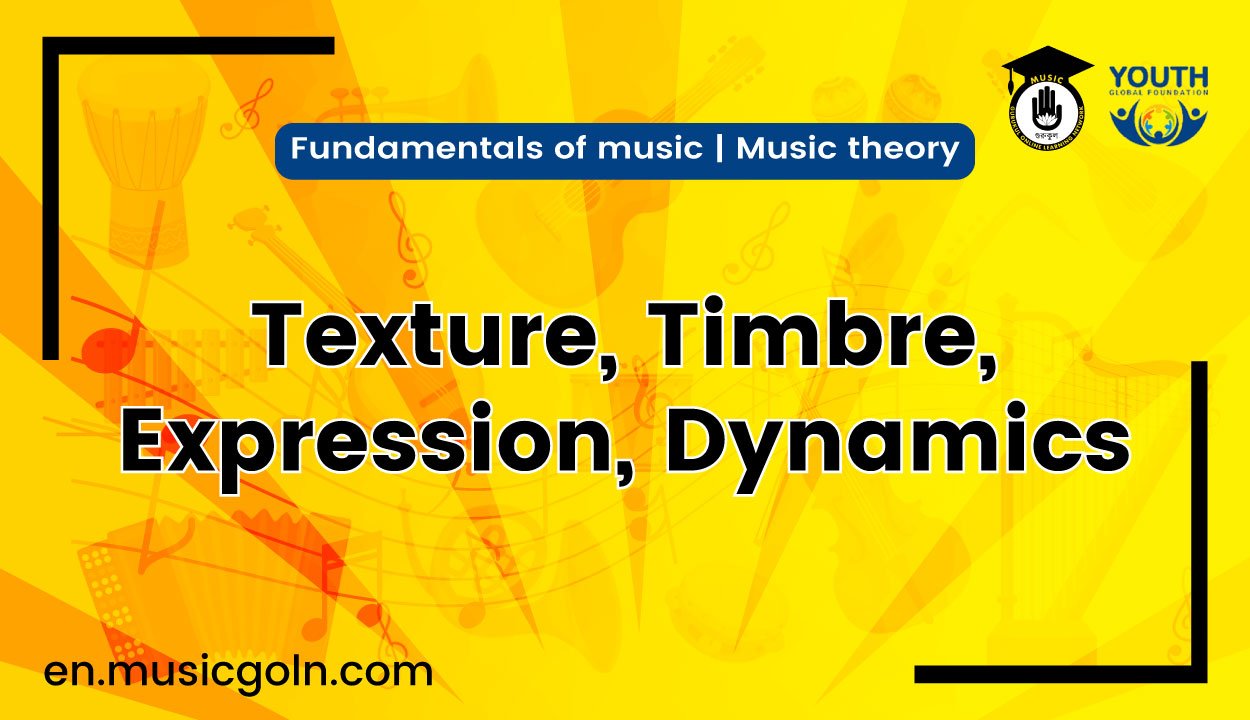Fundamentals of music, Music is composed of phenomena of sound, and “music theory” considers how those phenomena are and can be used in music. Music theory includes considerations of melody, rhythm, counterpoint, harmony, and form; tonal systems, scales, tuning, intervals, consonance, dissonance, durational proportions, and the acoustics of pitch systems; composition, performance, orchestration, ornamentation, improvisation, and electronic sound production; etc.
Table of Contents
Texture
Musical texture is the overall sound of a passage or complete composition, commonly described according to the number of and relationship between parts or lines of music: monophony, heterophony, polyphony, homophony, or monody. The perceived texture of a piece can also be affected by the timbre of the instruments, the number of instruments used, and the intervallic distance between each musical line, among other things. Its theoretical interest includes its effects on perception, form, and style.
Timbre
Tim bre, sometimes called “color”, or “tone color,” is the principal phenomenon that allows us to distinguish one instrument from another when both play at the same pitch and volume, a quality of a voice or instrument often described in terms like bright, dull, shrill, etc. It is of considerable interest in music theory, especially because it is one component of music that has as yet, no standardized nomenclature. It has been called “…the psych acoustician’s multidimensional waste-basket category for everything that cannot be labeled pitch or loudness
,” but can be accurately described and analyzed by Fourier analysis and other methods because it results from the combination of all sound frequencies, attack and release envelopes, and other qualities that comprise a tone.
Tim-bre is principally determined by two things: the relative balance of overtones produced by a given instrument due to its construction (e.g. shape, material), and the envelope of the sound (including changes in the overtone structure over time). Tim-bre varies widely between different instruments, voices, and to a lesser degree, between instruments of the same type due to variations in their construction, and significantly, the performer’s technique.
The timbre of most instruments can be changed by employing different techniques while playing. For example, the timbre of a trumpet changes when a mute is inserted into the bell, and the player changes their embouchure or volume. A voice can change its tim-bre by the way the performer manipulates their vocal apparatus, (e.g. the shape of the vocal cavity or mouth). Musical notation frequently specifies alteration in timbre by changes in sounding technique, volume, accent, and other means.
These are indicated variously by symbolic and verbal instruction. For example, the word dolce (sweetly) indicates a non-specific but commonly understood soft and “sweet” timbre. Sul tasto instructs a string player to bow near or over the fingerboard to produce a less brilliant sound. Cuivre instructs a brass player to produce a forced and stridently brassy sound. Accent symbols like marcato (^) and dynamic indications (pp) can also indicate changes in tim-bre.
Expression
Expression is created by nuances of any phenomena of sound including timbre, variation of pitch, tempo, volume, etc. Due to its great effect on perception and emotional response, it is of particular interest in music theory. Although frequently indicated in music notation verbally or by symbols, those indications are imprecise in comparison to elements like pitch, and so highly dependent on the interpretation and performance of the player. For example, although pianissimo pp and the word dolce indicate a low volume and sweet or tender feeling, precisely how quietly and with what technique they may be played is subject to the player’s interpretation. Common music notation is incapable of directing every aspect of a player’s performance.
Dynamics
In music, “dynamics” normally refers to variations of
intensity or volume, as may be measured by physicists and audio engineers in decibels or phons. In music notation, however, dynamics are not treated as absolute values, but as a relative one. Because they are usually measured subjectively, there are factors besides amplitude that affect the performance or perception of intensity, such as timbre, vibrato, and articulation. The conventional indications of dynamics are abbreviations for Italian words like forte (f) for loud and piano (p) for soft.
These two basic notations are modified by indications including mezzo piano (mp) for moderately soft (literally “half-soft”) and mezzo forte (mf) for moderately loud, sforzando or sforzato (sfz) for a surging or “pushed” attack, or fortepiano (FP) for a loud attack with a sudden decrease to a soft level. The full span of these markings usually ranges from a nearly inaudible pianissississimo (PPP) to a loud-as-possible fortissississimo (off).
Greater extremes of PPP PPPand fffff and nuances such as p+ or più piano are sometimes found. Other systems of indicating volume are also used in both notation and analysis: dB (decibels), numerical scales, colored or different sized notes, words in languages other than Italian, and symbols such as those for progressively increasing volume (crescendo) or decreasing volume (decrescendo), often called “hairpins” when indicated with diverging or converging lines as shown in the graphic above.
